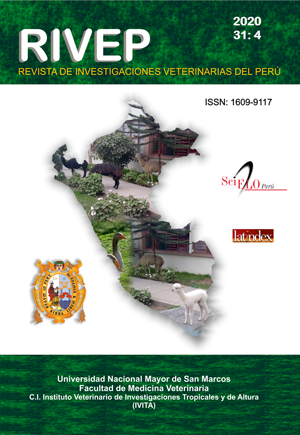Control of the emergence of the follicular wave by the application of oestradiol benzoate, GnRH and follicular ablation in the late metaoestrous in heifers in the high tropics
DOI:
https://doi.org/10.15381/rivep.v31i4.17009Keywords:
metestrus, dynamics, recruitment, hormoneAbstract
The response of the dominant follicle (DF), the profile of the FSH and estradiol and the onset of the follicular wave after the application of estradiol benzoate, GnRH, or follicular ablation in late metestrus were characterized in crossbred Holstein heifers, reared at 2500 meters above sea level and fed to grazing. Nine animals weighing 427.7±23.0 kg, body condition 2.7±0.1, age 26.7±1.4 months were used. Before the experiment, the heifers were synchronized and day 6 of the oestrous cycle was considered day zero (start of the experiment). There were three treatments: T1 = Oestradiol benzoate - BE (n=9), T2 = GnRH (n=9), T3 = Ablation (n=9). The evaluation of the DF was carried out by ultrasound every 24 hours, for 5 consecutive days. FSH and oestradiol levels were analysed every 5 days from day 0 by radioimmunoassay. The onset of the follicular wave and number of follicles recruited were determined retrospectively when assessing the daily ultrasound. The application of BE (T1) caused an initial growth of the DF, then it was maintained and finally went to atresia, the peak of FSH appeared at 48h (0.87±0.21 ng/ml) and the onset of the follicular wave was at 3.2±0.15 d post-treatment. In T2, 55.5% of the heifers ovulated in 24h and 44.5% between 24-48h, the peak of FSH was at 24h post-treatment and the onset of the wave in 2.4±0.18 d. The T3 heifers showed the FSH peak at 24h and wave restarted at 1.8±0.15 days. It is concluded that the application of BE in the heifers of the study favoured then an earlier restart of the follicular wave. Besides, the presence of corpus luteum and DF prior to the application of GnRH and ablation allows a more solid and homogeneous restart of the follicular wave.
Downloads
Downloads
Published
Issue
Section
License
Copyright (c) 2020 Luis Eduardo Ayala Guanga, Pedro Emilio Nieto Escandón, Ermes Ramiro Rodas Carpio, Santiago Xavier Sarmiento Quito, Jorge Bolívar Dután Sanango

This work is licensed under a Creative Commons Attribution-NonCommercial-ShareAlike 4.0 International License.
AUTHORS RETAIN THEIR RIGHTS:
a. Authors retain their trade mark rights and patent, and also on any process or procedure described in the article.
b. Authors retain their right to share, copy, distribute, perform and publicly communicate their article (eg, to place their article in an institutional repository or publish it in a book), with an acknowledgment of its initial publication in the Revista de Investigaciones Veterinarias del Perú (RIVEP).
c. Authors retain theirs right to make a subsequent publication of their work, to use the article or any part thereof (eg a compilation of his papers, lecture notes, thesis, or a book), always indicating the source of publication (the originator of the work, journal, volume, number and date).



